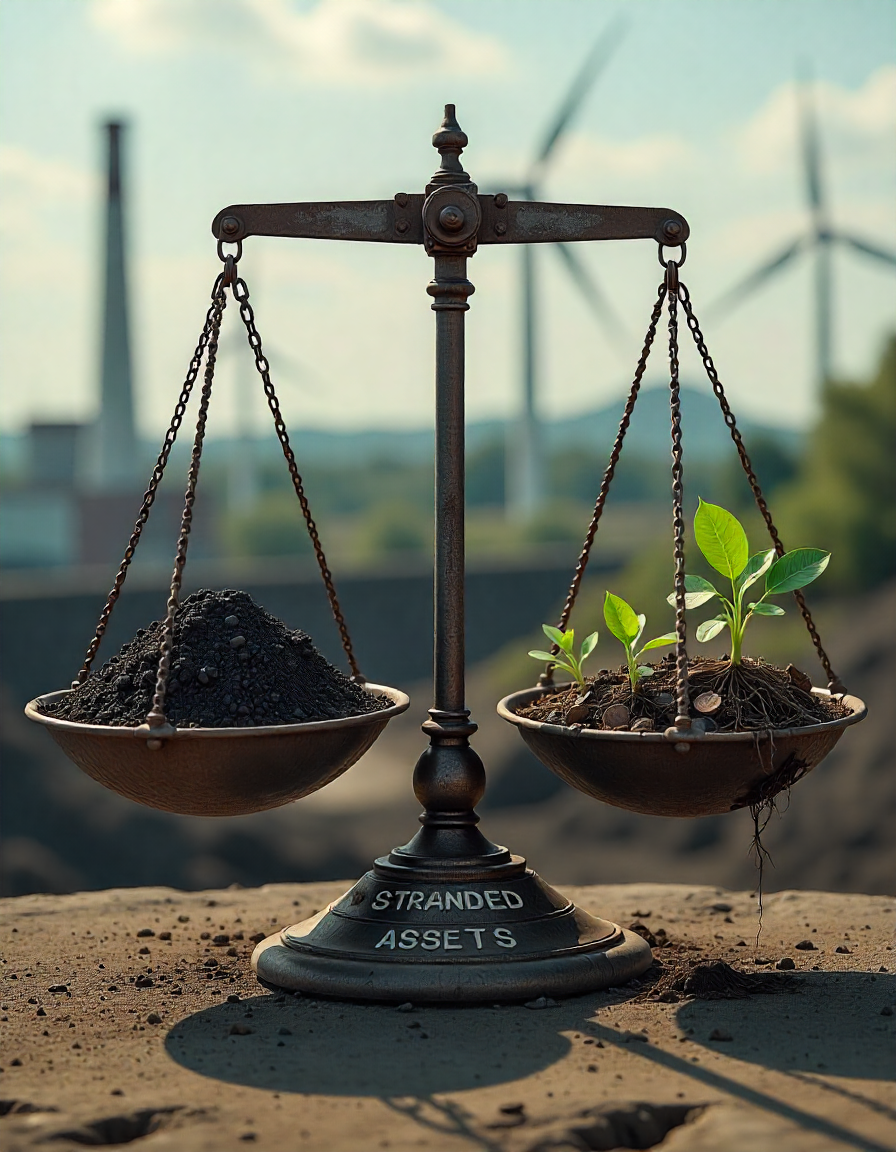In the fading light of an Appalachian evening, a third-generation coal miner watches as dismantling equipment arrives at the mine entrance. His grandfather’s pickaxe hangs above the fireplace, a relic of an era that powered nations but now faces an inevitable reckoning. This personal moment encapsulates the greatest economic transformation of our time: the global shift from carbon-intensive to sustainable economies. Unlike previous industrial revolutions driven by innovation and opportunity alone, this transition carries the weight of existential necessity, creating unprecedented economic challenges and opportunities that will redefine prosperity for generations.
The Stranded Asset Dilemma: Rewriting Balance Sheets
Beneath the surface of global financial markets lies a ticking time bomb: an estimated $1-4 trillion in fossil fuel assets that could become worthless as climate policies tighten. These “stranded assets” represent not just corporate losses but potential systemic risks to financial stability. When oil reserves in the ground can no longer be extracted, or coal plants must shut down decades before their expected lifespan, the economic ripple effects extend far beyond energy companies.
Consider the case of coal-dependent regions. In Wyoming’s Powder River Basin, coal production has plummeted 50% since 2008, taking with it tax revenues that funded schools, hospitals, and infrastructure. The suddenness of this decline creates economic trauma similar to deindustrialization in the 1980s, but with an added urgency: climate science demands an even faster transition. Yet our economic systems remain ill-equipped to manage this deliberate phase-out of major industries.
The financial sector has begun responding, but cautiously. Some institutional investors have started divesting from fossil fuels, while others argue for engagement as shareholders to push for transition strategies. Central banks are increasingly incorporating climate risks into financial stability assessments, recognizing that environmental factors now represent material economic threats. However, the pace of financial adaptation lags dangerously behind the physical reality of climate change.
The Just Transition Imperative: Beyond Economic Efficiency
Economic transitions always create winners and losers, but climate change adds moral urgency to ensuring equity. The concept of “just transition” has moved from activist slogan to policy principle, acknowledging that the costs of decarbonization cannot fall disproportionately on workers and communities that built the carbon economy.
Germany’s Ruhr Valley offers a compelling case study. Once Europe’s coal and steel heartland, the region has transformed into a hub for renewable energy research and advanced manufacturing. This transition took decades and required sustained investment in retraining programs, infrastructure renewal, and social support systems. Crucially, it involved workers and communities in planning their own futures, rather than imposing solutions from above.
Contrast this with approaches that prioritize economic efficiency above all else. When market forces alone drive transition, vulnerable communities often face devastating consequences with inadequate support. The human cost includes not just job losses but eroded social capital, identity crises, and public health impacts. Economic policies that ignore these dimensions create backlash that can derail climate action altogether, as seen in political resistance to carbon pricing in various jurisdictions.
Successful just transition strategies share common elements: early planning for affected industries, income support during transitions, retraining aligned with actual job opportunities, and investments in community renewal. They also recognize that transition support isn’t charity but sound economics—preventing long-term social problems that would ultimately cost more to address.
The Renewable Energy Revolution: Economics at Scale
The most encouraging aspect of the climate transition is the dramatic cost reduction in renewable energy technologies. Solar photovoltaic costs have plummeted nearly 90% in the past decade, while wind turbine costs have fallen by 70%. These improvements weren’t accidental but resulted from deliberate policy choices including research funding, deployment incentives, and economies of scale.
This cost revolution has fundamentally changed the economic calculus of energy. In many parts of the world, renewable energy now outcompetes fossil fuels on pure market terms, even without accounting for environmental externalities. The International Energy Agency reports that solar power now offers the cheapest electricity in history. This creates a powerful economic momentum behind decarbonization that complements environmental necessity.
However, the transition involves more than simply swapping energy sources. Renewable systems have different characteristics—intermittency, geographic distribution, infrastructure requirements—that demand reimagining entire energy systems. The economic opportunities extend beyond generation to storage technologies, grid modernization, and energy efficiency solutions. Each represents a market potentially worth trillions as global energy systems transform.
Carbon Pricing: The Economic Tool We Can’t Afford to Ignore
Among economists, carbon pricing stands as the most efficient way to reduce emissions while minimizing economic disruption. By putting a price on greenhouse gas emissions—whether through taxes or cap-and-trade systems—carbon pricing creates incentives for businesses and consumers to reduce their carbon footprint while allowing market forces to determine the most cost-effective methods.
The theoretical elegance of carbon pricing hasn’t translated easily into political practice. Only about 20% of global emissions are covered by carbon pricing initiatives, and most prices remain far below levels needed to achieve climate goals. Political resistance stems from legitimate concerns about competitiveness impacts and distributional consequences, particularly for low-income households who spend a larger portion of their income on energy.
Innovative policy designs can address these concerns. British Columbia’s carbon tax includes revenue recycling that returns most proceeds to citizens through tax cuts, making the policy progressive overall. California’s cap-and-trade system directs revenue to disadvantaged communities and clean energy investments, building broad political support. The European Union’s Carbon Border Adjustment Mechanism addresses competitiveness concerns by leveling the playing field for domestic industries.
Despite these challenges, carbon pricing remains essential for efficient decarbonization. Without it, we risk more costly and less effective regulatory approaches that could slow the transition while creating economic distortions.
The Circular Economy: Redefining Production and Consumption
Climate imperatives are driving a deeper rethinking of economic models beyond energy systems. The linear “take-make-waste” approach that defined industrialization is inherently incompatible with ecological limits. The circular economy offers an alternative: designing systems where materials continuously cycle through reuse, repair, remanufacturing, and recycling.
This transformation represents profound economic opportunities. The Ellen MacArthur Foundation estimates that circular approaches could generate $4.5 trillion in economic benefits by 2030 while addressing environmental challenges. Companies like Philips, which now offers lighting as a service rather than selling bulbs, demonstrate how circular models can create new revenue streams while reducing resource consumption.
The transition requires reimagining business models, supply chains, and consumer relationships. Products designed for disassembly and repair create different economic dynamics than disposable goods. Business models based on performance rather than ownership align corporate success with resource efficiency. These shifts challenge deeply entrenched practices but offer pathways to prosperity within planetary boundaries.
Financing the Transition: Mobilizing Capital at Scale
The scale of investment required for climate transition is staggering—estimates suggest trillions annually across the global economy. Current investment flows remain far below these levels, creating a critical financing gap. Mobilizing this capital represents one of the great economic challenges of our time.
Public finance alone cannot meet this need. The solution lies in redirecting private capital toward sustainable investments through a combination of policy signals, risk mitigation, and innovative financial instruments. Green bonds have grown exponentially, reaching over $500 billion annually, but remain a small fraction of global bond markets. Sustainability-linked loans tie interest rates to environmental performance, creating financial incentives for corporate decarbonization.
Development banks play a crucial role by de-risking investments and demonstrating new business models. The European Investment Bank and Asian Development Bank have increasingly focused their activities on climate-aligned investments, leveraging their capital to attract private sector participation.
Carbon markets also offer potential financing mechanisms, though current voluntary markets suffer from integrity challenges. Robust carbon credit systems could generate significant funding for nature-based solutions while supporting transition in developing economies.
The Global Dimension: Equity and Differentiated Responsibilities
Climate change is fundamentally a global problem, but economic capacity to address it varies dramatically. The principle of “common but differentiated responsibilities” acknowledges that developed nations, having benefited from carbon-intensive development, bear greater responsibility for both reducing emissions and supporting transition in developing countries.
This creates complex economic dynamics. Developing countries need access to clean technologies and financing to pursue low-carbon development pathways. Technology transfer mechanisms and climate finance commitments from developed nations remain insufficient despite repeated pledges. Meanwhile, industries in countries with stringent climate policies worry about competitiveness against producers in regions with weaker regulations.
International cooperation frameworks attempt to address these challenges through mechanisms like the Green Climate Fund and technology collaboration initiatives. However, progress remains slow compared to the urgency of climate change. The economic stakes are enormous: without greater global cooperation, we risk both catastrophic climate outcomes and destructive economic fragmentation.
The Path Forward: Economics as If People and Planet Mattered
The climate transition represents not merely an economic challenge but an opportunity to redefine prosperity itself. Traditional metrics like GDP growth fail to capture wellbeing, sustainability, or equity. New economic frameworks are emerging that incorporate these dimensions, from Bhutan’s Gross National Happiness to New Zealand’s Wellbeing Budget.
This broader perspective recognizes that the ultimate purpose of economic activity is to support human flourishing within ecological limits. The climate transition, while disruptive, offers a chance to correct course toward economic systems that deliver genuine prosperity rather than simply measuring material throughput.
The path forward requires multiple transformations simultaneously: technological innovation to decarbonize physical systems, policy evolution to create enabling frameworks, financial realignment to mobilize capital, and social adaptation to ensure equity. None of these will happen automatically—they result from deliberate choices shaped by our values and priorities.
The economic systems that emerge from this transition will look different from those of the carbon era. They will likely be more decentralized, more circular, and more focused on wellbeing than pure output. The transition won’t be easy or smooth, but the alternative—continuing with systems that destabilize our climate and undermine our future—is economically unthinkable.
As we stand at this economic crossroads, the choices we make today will determine whether the transition is just and prosperous or chaotic and divisive. The tools and technologies exist; what remains is summoning the collective will to deploy them wisely and equitably. The great economic transformation of our time has begun—its ultimate shape depends on us.

